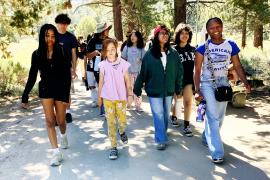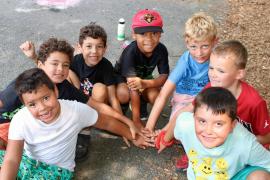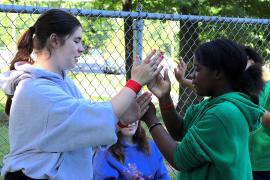Strategic thinking can’t possibly be for frontline camp staff — or can it? That level of decision-making is historically reserved for owners, directors, and senior management to discuss behind closed doors. These positions decide and dictate the intentional thought process that influences the long-range plans for the camp. Or do they?
When I ask camp leaders who the strategic thinkers are for their respective camps, I typically get responses reflective of those positions I just listed, because they have camp knowledge and can make conscious decisions to put the camp on the road to success. While this is certainly appropriate and has foundational merit, why should the input stop there?
Developing camp leadership is an ongoing process even for seasoned camp professionals. While many camps offer a leadership program for personal development, not all staffing structures include ways for everyone to contribute to strategic thinking. In some cases, age, experience, or education may prevent staff from being real contributors, but providing the framework for their positional involvement can be very beneficial.
Strategic thinkers set goals, distribute resources, recognize the risks and tradeoffs when making decisions, and create advantage by offering superior value (Horwath, 2023). Depending on your staffing plan, you may have more options for strategic input than traditional models allow by including activity specialists, head counselors, program staff, and support personnel. In addition, kitchen, medical, transportation, or maintenance staff can increase your learning options by providing opportunities for decision-making in nonprogrammatic areas.
What Are Strategic-thinking Skills?
To provide innovative programming or support for long-standing camp traditions, staff use strategic thinking to solve logistic and planning problems. By design, some decisions are time-sensitive while others will apply to future weeks or years. Critical skills are essential concepts for staff to master, because then they can identify, address, and solve obstacles in support of the camp’s mission.
You can tier the decision-making level to reflect the age and experience of the staff responsible for the outcome, and it is important to define what critical skills are and how they connect to the desired result.
For example, the decision to offer a new camp activity requires analysis. You will have to consider time, resources, budget, purpose, scheduling, or a combination of all these factors. After the initial analysis is completed, a staff meeting needs to be called to see if the activity will be possible. Your goal is to facilitate meaningful dialogue from everyone involved by teaching them how to think strategically.
In addition to analytical skills, the ability to communicate the idea requires collaboration to ensure everyone is working toward a shared goal. This means talking to staff to make sure they understand what you are trying to accomplish. Next, the idea needs an implementation plan. This requires internal and external problem-solving to address challenges such as tired staff, temperature, available space, existing workload, or rain. Lastly, someone at the counselor, mid-level, or specialist level must be named to manage the activity.
Teaching staff from all levels to ask probing questions will enhance their ability to understand the process. “How can we get the 10-year-olds to do this?” “What’s the reason for dividing a group?” If you had success offering a particular activity last summer, how can you improve on the idea this year? What might it look like three years from now, and how does that relate to the changing times of social development? Teaching your process will empower additional levels of staff to think strategically.
Lead by example. You can model this behavior by using your camp’s traditions as a foundation for ideas. Ask staff to identify and reflect on a tradition, especially on its relevance. Does it still serve its original purpose? If not, have staff gather information and, if needed, provide a viable alternative that might involve an additional location or staffing setup. This may attract new campers or get first-year staff interested in new possibilities. If nobody comes up with an idea, try to invite discussion by asking a question or two. “Will campers be bored by doing the same old thing? Does this tradition still need to be observed, or is it tired and outdated?” A little discourse can be a very healthy tactic toward stimulating good conversation.
If ideas are headed in the right direction but are not quite where they need to be, ask senior staff to provide some direction. Doing so should move the process from the why to the how, which is an easier path for staff to manage.
Teaching Skills
Because nobody comes to camp specifically to learn strategic thinking, you can help staff by teaching them how to ask questions differently. The trick is to pick a topic or problem that relates to a challenge or something they want and then make it personal. I refer to this as the chocolate chip cookie approach. The cookie is good by itself, but when you add those chocolate chips, the cookie tastes better.
Let’s say you are planning a special event that traditionally has always been done the same way. But this year you want to add a new component. Show some courage and let staff figure it out. This scenario perfectly aligns with helping staff to learn the practice of asking strategic questions. Part one is empowering staff to be inclusive with the new component by identifying new opportunities, finding creative ways to alter schedules, or generating resourceful ways to increase camper motivation. Part two is choosing people who have a vested interest in the outcome, because they will be more passionate about the process.
Here are some sample questions:
- How will including the new component change planning the strategy for the event?
- How does the event support the camp’s mission (e.g., retention, skill development, or increased social interaction)?
- Where can additional resources come from to improve the event for this year or next year?
- Who will be unhappy about the change to the event, and what options can you provide them?
- Why is making the change important?
The camps that intentionally put strategic thinking into practice will receive immediate benefits from their efforts. Explanations become more focused, and a greater sense of ownership becomes evident. In addition to introducing topics like competitive advantage, resource allocation, and adaptability, this exercise will help staff learn to articulate what is special about your camp.
Explain to staff that competitive advantage or other associated benefits you identify do not have to be programmatically complicated. Counselors have always had a big impact on camper experience by developing creative ways to teach activities. Use this leadership opportunity to your advantage by intentionally adding a more formalized strategic process.
Challenge staff to meet each of the benefits you outline by researching trends, including new aspects of teaching, using equipment in a different way, or changing the rules to achieve desired outcomes. You can do this in several ways but start at an easy level by having staff alter the rules of a popular game or sport. Tell them to be creative. Ask what the competitive advantage would be by doing this. Another way is to identify current trends and include them into activities like tech-enhanced coaching or environmental responsibility. Use the same format to analyze each of the benefits you deem appropriate, and make sure you outline when or if their ideas are feasible.
Concentrate on teaching strategies that help staff to make choices based on fact rather than emotion. This will support the camp’s vision while pointing out how to deal with default behaviors such as micromanagement, responding to the first reaction, or not asking for guidance during a high-pressure situation. The idea is for staff to avoid impulsive decisions that could have a negative, trickle-down effect and replace them with more user-friendly strategies. Help them to shift their focus to a more unified management approach that uses strategic thinking to meet program goals.
Training tip: make this challenge fun by role-playing typical camp scenarios that require both easy and hard decisions.
The Three P’s
The easiest way to include strategic thinking practice in your staff training is to implement the three P’s into your leadership curriculum: personal, program, and process. You can break it down into concepts staff will readily understand.
First, have staff do a personal evaluation of their own skills. This should be a comprehensive identification of their talents, hobbies, and abilities that they may be able to utilize in the course of their jobs. Keep a comprehensive list of these attributes to inform your programming decisions as well as to identify opportunities for strategic collaboration.
Program implementation requires planning, monitoring, staffing, and problem-solving. This task-orientated behavior begins with effective communication and requires meetings that have clear objectives with stated goals. A division of responsibilities follows, which should include some sort of metric to evaluate job completion. Leadership styles need to be identified so you can set staff up for success. Carefully match knowledge with personality traits and predict where program difficulties may arise.
Process, in its simplest form, is something you do to achieve a certain result. A good leadership program teaches ways to control skill implementation by providing vision, techniques to evaluate ideas, and a fundamental understanding of logistics. All camp activities have basic requirements, so articulate your format by introducing staff to a series of decision-making events that span a spectrum of responsibility. For example, younger staff can figure out cleanup procedures, while older staff can plan a camp-wide event.
The Why
Staff need to know the rationale behind adding strategic thinking to their camp experience. Gen Z is a goal-oriented, tech savvy, well-educated generation that has been through a recession and COVID-19. They grew up with the iPhone and very diverse demographics. Telling them why strategic thinking is important because in the world of social media and instant information, they tend to be anxious and need ways to develop leadership skills.
The structure of camp provides an easy way to incorporate this type of program because it already includes some key elements for strategic development. Since staff learn from more experienced leaders, mentorship provides an easy way to develop individual and group management styles. Each day, staff do activities and adapt to things like weather and skill development, so they can also gain a lot of practical experience when they take on different leadership roles.
Starting with pre-camp functions and going through the summer, staff learn the value of networking. Make sure you do not overlook how and when this is occurring. Social interaction is part of the continuous learning camps provide, and it has a huge effect once camp is over. Another element staff can use is reflective thinking. This provides staff with a way to process what happened in both the short and long term. Through trial and error and periodic evaluations, counselors can fine-tune their decision-making process in a controlled and safe environment.
Strategic thinking specifically leads to increased transactional value for leadership development. Staff can take what they learned at camp and use it at school or other jobs because both have structure and goals. Additionally, each system features praise or rewards that provide valuable support for desired behavior. This allows staff to build on their successes even when new topics are introduced. Examples of skills that transfer after camp range from personal accountability to group management. Once this curriculum is vetted and implemented, make a list of specific competencies staff will learn and help them to make connections to how these may be used in their individual futures.
Include strategic thinking in your leadership program to solidify staff understanding of the importance of quality decision-making. Work on communication, analytical skills, collaboration, and problem-solving until the process of leading by example and asking probing questions feels organic. Challenge their competitive side by having them provide some of the rationale for changing a special event and concentrate on easy decision-making. The three P’s will enable you to implement strategic skills in a language staff can understand. Finally, introduce the “Why,” or the reasons for the increased responsibility. Be sure to outline the transactional value of the program and let them know how important they are to camp’s success.
Reference
Horwath, R. (2023). Become a better strategic thinker. Harvard Business Review.
Greg Cronin, MPA, CCD, CPRP, was a camp director for over 30 years and has been training staff since the early 1980s. He is a nationally known conference speaker, consultant, staff trainer, author, former American Camp Association National Board member, standards visitor, and corporate trainer with more than 200 clients nationwide. Greg has trained thousands of camp staff on youth development and leadership. He has appeared on TV, radio, and Capitol Hill as a spokesperson for the camp experience and is a frequent contributor to Camping Magazine. Greg is featured in ACA’s By the Expert book series with chapters on leadership and staff training. To book Greg for staff orientations, training, and workshops, please call 703-395-6661 or email [email protected].



